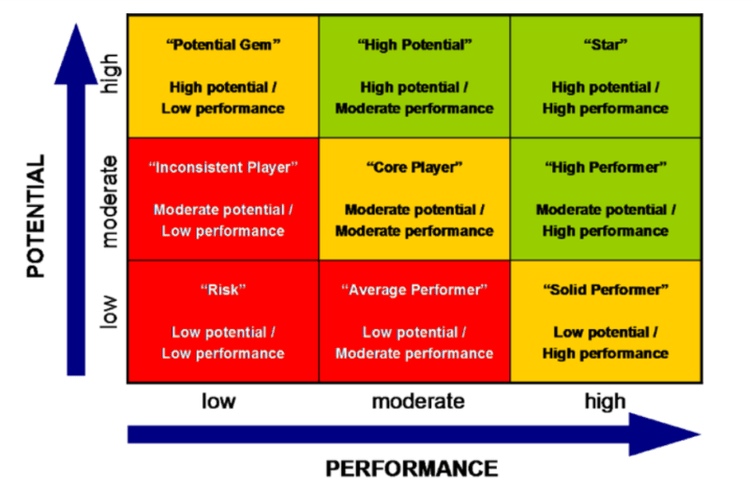Succession Planning Utilizing 9 Box
"Who will be leading your company in 5 years?”
This simple yet powerful question often elicits raised eyebrows and nervous laughter from even the most confident founders and business leaders. Some dismiss it as a concern for the distant future, while others optimistically assume they'll have sold their company by then. But here's the truth: succession planning isn't just about having a backup for the founder—it's about cultivating a robust leadership pipeline throughout your entire organization.
As a founder, your vision may have launched the company, but its longevity depends on your ability to nurture a team that can steer the ship through both calm and stormy seas. So, let's dive into why this question should be at the forefront of your mind, and how answering it can transform your approach to building a resilient, future-proof business.
Source: BambooHR
Why the 9 Box is Your Secret Weapon in Succession Planning
For founders and business leaders, their success is dependent on the talent of their teams and organizational resiliency in an unpredictable world, the 9 Box model has a huge impact on how things are done. Here's why:
Big Picture: It gives you a full view of your talent pool, helping you spot hidden gems and people who might leave.
Strategic Resource Allocation: When you know where your talent stands, you can allocate resources more effectively to develop and retain your employees.
Future-Proofing: This lets you spot and grow future leaders, making sure you have a strong pipeline of leaders.
Targeted Development: Each box points to different ways to develop, allowing you to create growth plans that fit each person.
Improved Retention: When you see and grow potential, you're likelier to keep your best people who feel valued and see a clear way to grow.
Best Practices: Making Sure Your 9 Box Implementation Is Fair
While the 9 Box model packs a punch, it works best when objective. Here are some tips to keep your assessments fair and on point:
Balance Bias with Different Viewpoints
Don't just listen to one manager. Set up a 360-degree feedback system to get insights from coworkers, team members, and other higher-ups. This well-rounded approach helps cancel out personal biases and gives a fuller picture of each worker.
Set Clear, Measurable Standards
Fuzzy evaluations result in biased outcomes. Create clear, measurable standards for both job performance and future potential. For job performance, this could include key indicators like how many clients stay with the company or how projects get done. For potential, think about how well someone handles new challenges or shows leadership skills in team projects. It is common for the potential to be determined subjectively. Try to align potential measurements to goals that are specific, measurable, and time-bound. Such skills, certifications, client feedback, and inter-departmental scoring.
Regular Alignment Meetings
Set up frequent meetings where managers from different parts of the company get together to discuss and agree on their evaluations. This approach involving different departments ensures everyone in the company is on the same page and helps spot any odd or mismatched evaluations.
Use Blind Reviews
To fight hidden prejudice, consider using a blind review process when you first assess people. Remove details that identify someone, such as names and pictures. Instead, look at how well they've done and signs of what they might do.
Ongoing Feedback System
Don't just use the 9 Box once a year. Set up a system for ongoing feedback where workers get regular updates on how they're doing and what they might achieve. This constant back-and-forth makes things clear and lets you fix things as they happen.
Leaders Need to Support and Learn
Ensure your leadership team grasps the importance and approach of the 9 Box model. Hold in-depth training to teach them how to use the tool well and without bias. When leaders buy in and know what they're doing, they're more likely to support the process and apply it.
Putting It All Together: Steps to Take
Want to tap into the strength of the 9 Box model in your company? Here's your plan of action:
Teach Your Team: Begin with a full training program for all managers and leaders participating in the assessment process.
Tailor Your Criteria: Adjust the performance and potential measures to fit your company's goals and culture.
Start Small: Begin with a test run in one department before introducing it to the whole company.
Use Smart Tools: Get HR software that backs up 9 Box evaluations and data analysis to make setup and monitoring easier.
Check and Improve: Often evaluate how well your 9 Box method works and be ready to adjust your approach based on input and outcomes.
By adopting the 9 Box model with these tips in mind, you're not just planning who will take over—you're fostering an environment of development, appreciation, and smart talent handling.
The 9 Box model can help you build a strong, high-performing organization that stays ahead of the game.

